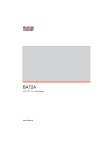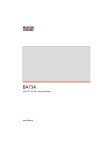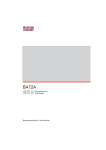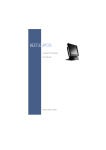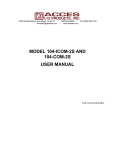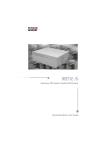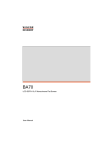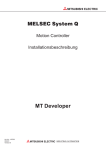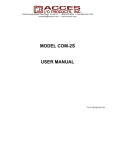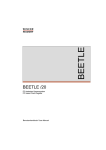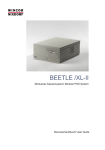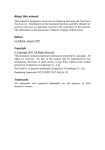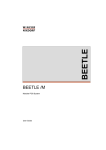Download Wincor Nixdorf BA71-R User manual
Transcript
BA71 / BA72 LCD TFT 10.4" Flat Screen LCD TFT 12.1" Flat Screen User Manual Herausgegeben von/Published by Wincor Nixdorf GmbH & Co. KG D-33094 Paderborn Bestell-Nr./Order No.: 0175 00 20397E Printed in Singapore BA71 / BA72 LCD TFT 10.4" Flat Screen / LCD TFT 12.1" Flat Screen User Manual Edition April 2001 MS-DOS®, Microsoft®, Windows 3.1 ®, Windows 95/98® and Windows NT® are registered trademarks of Microsoft Corporation. OS/2® is a registered trademark of IBM Corporation. BEETLE® is a registered trademark of the Wincor Nixdorf GmbH & Co. KG. Copyright © Wincor Nixdorf GmbH & Co. KG, 2001 The reproduction, transmission or use of this document or its contents is not permitted without express authority. Offenders will be liable for damages. All rights, including rights created by patent grant or registration of a utility model or design, are reserved. Delivery subject to availability; technical modifications possible. Contents Introduction ............................................................................................... 1 From Point-of-Sale to Point-of-Service................................................... 1 Advantages at a Glance.............................................................................. 2 Unpacking and checking the Delivery Unit ................................................. 3 About this Manual........................................................................................ 3 BA71 and BA72 Components .................................................................. 4 Screen Module ............................................................................................ 4 LCD Controller............................................................................................. 5 TFT Controller for BA71 and BA72 ............................................................. 6 Capacative Touch Screen (Option)............................................................. 8 General ..................................................................................................... 8 How to Operate ....................................................................................... 10 Cleaning Instructions .............................................................................. 10 AT COM Board for Touch Screen........................................................... 11 I/O-Addresses of COM Interfaces ........................................................ 11 COM Interface Interrupts ...................................................................... 12 Assignment of COM port addresses and interrupts (installation details) 13 IRQ9, conflict with powerfail interrupt of BEETLE systems ................. 13 IRQ10, conflict with COM3, COM4 of BEETLE systems ..................... 13 IRQ11, most likely conflict SCSI controller or USB .............................. 13 IRQ12, most likely conflict Mouse Port or PS/2 Mouse ....................... 14 IRQ15, most likely conflict IDE controller ............................................. 14 Adding COM ports under Windows NT ................................................ 14 Adding COM ports under Windows 9x ................................................. 14 Using shared interrupts for COM ports with Windows NT ................... 15 Using shared interrupts for COM ports under Windows 95 ................. 17 Using COM ports under Windows 3.x .................................................. 17 Using COM ports under DOS ............................................................... 17 TFT Adapter .............................................................................................. 19 Resistive Touch Screen (Option)20 General ................................................................................................... 20 How to Operate ....................................................................................... 21 Cleaning Instructions .............................................................................. 21 Installing and Securing the Screen into Place .....................................23 Installing the BA71 / BA72 into Place (Table Top Version).......................23 Securing the screens into Place (Tubular Stand Version) ........................24 Adjustable Screen Angle ...........................................................................25 Ergonomic Terminal Workplace ................................................................26 Installation ................................................................................................27 Installing the Controller in the BEETLE /L .................................................27 Connecting the Speaker Cable ...............................................................29 Connecting the BA71/BA72 to the BEETLE /L..........................................29 Connecting the BA71/BA72 to the BEETLE /20........................................31 Connecting the BA71/BA72 to the BEETLE /XL .......................................31 Connecting the BA71/BA72 to the PC.......................................................32 Connecting the BA71/BA72 to the BEETLE/M..........................................32 The Jumper layout of the GXm board ....................................................33 Touch function (COM2 disable)) .............................................................34 COM2 function (touch disable)................................................................34 Connecting the cable...............................................................................35 Installing a TFT adapter.............................................................................36 Inserting the Cable.....................................................................................37 Releasing the Cable Connection ..............................................................38 Software Installation................................................................................39 Software Interfaces..................................................................................40 Touch Screen ............................................................................................40 TFT LCD Flat Screen.................................................................................40 Automated Logic Diagram (ALD) and Pin Assignments ....................41 Interface .....................................................................................................42 Inverter (High-Voltage Generator) .............................................................42 Touch Screen and Controller.....................................................................42 Pin Assignments ........................................................................................43 BA71/BA72 Connectors of the Controller and the Interface ...................43 COM 6 Interface of the Controller ...........................................................44 Internal Speaker Connector for Controller and BEETLE-CPU ...............44 COM7 and COM8 Interfaces of the Controllers for the BEETLE /XL ....44 Internal Connecting Socket...................................................................45 External Connecting Socket..................................................................46 Technical Data ........................................................................................ 47 Touch Screen (optional)............................................................................ 47 LCD Screen............................................................................................... 48 BA71.......................................................................................................... 49 BA72.......................................................................................................... 50 Current Consumption ................................................................................ 51 TFT Controller ......................................................................................... 51 Screen Module........................................................................................ 51 COM6/7/8................................................................................................ 51 Power Consumption .................................................................................. 51 TFT Controller ........................................................................................... 52 COM Board ............................................................................................... 53 Manufacturer’s Declaration and Approval............................................ 54 General Authorization ............................................................................... 54 FCC-Class A Declaration .......................................................................... 54 Tested Safety ............................................................................................ 55 User Information........................................................................................ 55 Safety Instructions..................................................................................... 56 Instructions for Maintenance ..................................................................... 57 Warranty .................................................................................................... 57 Recycling ................................................................................................... 57 Appendix .................................................................................................. 59 Abbreviation Index..................................................................................... 59 Introduction From Point-of-Sale to Point-of-Service “The customer is king”, a motto that seems so simple and yet it demands a forever increasing supply of goods and services, both quantitatively and qualitatively. More customer service and more customer information have transformed the point-of-sale to a point-of-service, as business transactions are becoming more complex and there are growing demands on shop assistants and personnel working on the cash till. Using the BA71 or BA72 provides you with a terminal-orientated, ergonomical and customer-friendly cashier’s workplace. Both screens differ from their screen diagonals (10.4" resp. 12.1", i.e. 26.4 cm resp. 30.7 cm) and from their dimensions. So, with the same technical brilliance of these screens you can choose which one fits best into the design of your workplace. Optionally BA71 and BA72 are equipped with a Touch Screen including a loudspeaker. Both screens can be applied in all trade market segments like specialist retailers, department stores, self-service stores, petrol stations or in restaurants. There is indeed a great deal of scope for implementing a BA71or a BA72. Introduction They can be used, for example, as: n an ordering terminal n an information terminal n a lottery terminal n a point-of-sale terminal n a training terminal. GB - 1 Introduction The low-energy, flickerfree and radiation-free colour monitor of the BA71 / BA72 is an Active-Matrix-Display in TFT-technology (Thin Film Transistor). Therefore, it is especially suited for multimedia applications as it offers brilliant colour representation, a better contrast ratio and a high display speed. The screens can be installed directly on the cashier’s desk or fastened to a tubular stand. Furthermore, they can also be set up on the central unit of a modular BEETLE system. Advantages at a Glance r r r r r r r r r r GB - 2 low footprint ergonomic terminal workplace key to customer service basis for animation and multimedia flickerfree and free from radiation high resolution high brightness very good contrast ratio high brilliant colours (up to 65538) wider viewing angle (less glare through crosslight) Delivery Unit Unpacking and checking the Delivery Unit Unpack the parts and check to see whether the delivery matches the information on the delivery note. The delivery comprises of the respective screen module. Controllers and data cables, necessary for operation, can be ordered separately. If damage has occurred during shipping or if the package contents do not match the delivery note, promptly inform your Wincor Nixdorf sales outlet. Transport the device only in its original packaging (to protect it against impact and shock). Delivery Unit About this Manual This manual tells you everything you might need to know for the installation (software and hardware), the operation and the maintenance of your BA71 or BA72. Some parts of this book require familiarity and experience in working with operating systems and installation and configuration procedures. GB - 3 BA71 and BA72 Components Screen Module The screen module represents the main unit of the BA71 / BA72. It comprises of a TFT-LCD colour screen, the TFT-interface and an inverter that generates the voltage for backlighting the screen. As an option the screens are available with Touch Screen and a loudspeaker included. Behind the cover on the back of the BA71 / BA72 you connect the cable. Remove the cable cover by pushing it in the direction of arrow (see picture) and then taking it off upwards. Back of the screen The TFT LCD flat screen is an SVGA-compatible 10.4 inch screen (12.1 inch with the BA72) which is absolutely flickerfree and free of radiation and has only a low heat emission. It is designed for a resolution of 800 x 600 pixel. Application programs should be used with this resolution! However, a resolution of 640 x 480 pixel is possible. In graphics mode this resolution is used during the start of the BIOS or with MS-DOS etc. It is also used for instance during installation or when configuration problems occur (protected mode of Windows). The resolution 640 x 480 pixel is implemented through “stretching” and therefore in graphics mode can not meet the quality of the resolution 800 x 600 pixel. GB - 4 LCD Controller “Stretching” is only possible when a separate TFT conroller is used. So, operating the BA71 / BA72 with the integrated TFT controller at the GXm CPU, “stretching” is not possible. Here you will see a black margin around the centered picture. If the display element is damaged and the liquid crystal solution leaks out onto your hands or clothing, please wash your hands or clothing immediately under running water for at least 15 minutes, using soap or alcohol. If the liquid comes into contact with your eyes, consult a medical doctor immediately. LCD Controller LCD Controller The following two main controllfunctions must be implemented in the LCD Controller: r r Controlling of TFT LCD display including PCI interface (TFT Controller) Controlling of RS232 COM 5, 6, 7, 8 including ISA interface (COM Board) for the touch version) Because of the different system interfaces - PCI and ISA - two seperate print circuit boards are necessary: the TFT Controller and the COM Board. So as not to waste an additional AT slot, this solution of two PCB´s is optimized for all BEETLE systems (/M, /L, /XL, /20, NetzPOS, S1) and for many PC systems. GB - 5 Screen Module /TFT Controller TFT Controller for BA71 and BA72 Screen Module /TFT Controller The TFT-controller used for BA71 / BA72 is identical with the one used for the SNIkey terminal. It is a plug-in-controller with a PCI-interface. There are two connections for r r a 50-pin MDR connector with integrated COM5 interface a 9-pin DSUB female (for COM6) COM5 and COM6 are only ready for operation when the optional COM board is used. The control data and data lines for the TFT LCD display are transmitted to the 50-pin MDR connector via hardware drivers and filters. The cable, which is linked up to the screen module, is connected to this MDR connector. The COM5 interface signals (for the Touch Screen) and the loudspeaker signal are also on this connector. A loudspeaker cable connects the beeper of the CPU to the loudspeaker connector of the controller. Please refer to the chapter “Installation” for further information. The screen panel next to the MDR connector has a 9-pin DSUB socket connector, to which the COM6 interface is connected. This is the interface with the power supply. This socket is always installed, but it will only work with the Touch Screen version. GB - 6 Screen Module /TFT Controller 6 1 9 5 2 50 1 Panel of TFT controller COM5/ COM6 1 4 Speaker connector BA71 / BA72 connector COM6 incl. COM5, LCD interface and loudspeaker MDR connector DSUB socket Board layout (TFT controller) GB - 7 Capacative Touch Screen (Option) General The TFT Touch Screen works according to the principle of a change in analog capacitance. It has a glass screen with a transparent, thin-film overlay on the surface. This is fully sealed and protected by a further layer of clear glass. Electrodes on the edges of the screen provide a uniform low-voltage field. As soon as you touch the screen with your finger the contact point is “recognized” by the change in capacitance. Because this takes place very quickly - 15 milliseconds after being touched - the Touch Screen is optimally equipped for a number of different requirements and applications. GB - 8 Touch Screen Anti Reflective Etched Surface and protection ClearTek Glass Overcoat Conductive Coating Protective Noise Shield The programming interface of the screen is identical to the mouse interface. Touch Screen Touch Screen and Sleep Mode Using the Touch Screen with a BEETLE Pentium CPU, an entry via touch during sleep mode may lead to a faulty input. During sleep mode nothing can be read from the LCD flat screen. Entries via touching the screen will still be processed by the system, but without the system “waking up”. For these reasons it is not recommended to set the sleep mode. For details please read the chapter “BIOS Setup” in the BEETLE User Guide. GB - 9 Touch Screen How to Operate The Touch Screen responds to the slightest contact, therefore you do not have to apply much pressure when working with the screen. This not only saves time, but is also kind to your joints! Touching the touch glass has the same effect as clicking the left mouse button. You need only apply a little pressure with the fingertip. In this capacitive process only fingertip contact is recognized. The screen does not react in any way if touched, for example, with a pencil or a glove. Cleaning Instructions The glass surface of the Touch Screen is insensitive to dirt, so you need only clean the screen from time to time. Always turn off the system before cleaning. The glass surface of your Touch Screen should be cleaned with a mild, commercially available glass cleaning product.All pH neutral materials (pH 6 to 8) are good for cleaning. Cleaners with pH values 9 to 10 are not recommended. Cleaning with water and isopropyl alcohol is as well possible. Do not use solvents containing acetic acid. Use a soft, fine-meshed cloth to clean the surface. Dampen the cloth slightly and then clean the screen. GB - 10 COM Board COM Board for Touch Screen COM Board The COM Board is an additional board with an ISA bus interface that has 2 or 4 COM interfaces (COM5, 6, 7, 8). The COM board is identical with the corresponding board of the SNIkey system. COM5 and COM6 are linked to the BA71 controller via a plug connector. COM5 is a reduced COM interface for RxD and TxD signals and is intended for the use of the (optional) touch function. As an option the COM board can be equipped with a COM7 and a COM8 interface. These can alternatively be operated as power-supplied interfaces (COM7* /COM8*) or as powerless interfaces (COM7 / COM8). I/O-Addresses of COM Interfaces The four COM interfaces of the COM board have the following I/O-addresses. Please refer to the table for the jumper settings. COM Address (Hex) 5 2E0 - 2E7 330 - 337 320 - 327 6 328 - 32F 338 - 33F 328 - 32F 7 3E0 - 3E7 340 - 347 360 - 367 8 368 - 36 F 348 - 34F 368 - 36F Jumper Position IO1 = open IO2 = open IO3 = open IO1 = closed IO2 = open IO3 = open IO1 = open IO2 = closed IO3 = open GB - 11 COM Board COM Interface Interrupts COM5 COM6 COM7 COM7-8 COM6-8 Interrupt IRQ9 I9 - - - I11 IR9 IRQ10 I10 - - - I12 IR10 IRQ11 I5 - I4 I8 I13 IR11 IRQ12 I1 - - - I6 IR12 IRQ15 I3 I2 - - I14 IR15 For the default setting the jumper I1, I2, I8, IR11, IR12 and IR15 are active (closed). The interrupts IRQ9 and IRQ10 are added for PC application only. For a correct reproduction of the interrupt signals it is necessary that the jumper IR9 to IR15 are not activated. To activate the interrupt request signal the corresponding jumper must be closed. To avoid possible conflicts with already existing plug-in-boards in your system, deactivate those jumpers on the COM board, that are not longer needed (opening the jumpers). GB - 12 COM Board Assignment of COM port addresses and interrupts (installation details) Ensure that there is no conflict of hardware port addresses or interrupt requests (IRQs) used by your system and the AT COM Board! Essentially the AT COM Board has been designed to be configurable for a non-shared IRQ9, IRQ10, IRQ11, IRQ12, or IRQ15 for COM5 and a shared IRQ9, IRQ10, IRQ11, IRQ12, or IRQ15 for COM6,7,8 and even COM5. The interrupt requests have to be enabled explicitly by jumpers on the controller (pls. see chapter 3 and 4). To assist you further, some hints to the assignment of interrupts are given in this chapter. Please note, that only some possible conflicts are mentioned. There might be more possible! IRQ9, conflict with powerfail interrupt of BEETLE systems IRQ9 cannot be used with BEETLE systems, since this in conflict with the powerfail interrupt. For other systems, no hint can be given for a conflict that is likely to occur. So you will have to check your specific configuration. IRQ10, conflict with COM3, COM4 of BEETLE systems IRQ10 cannot be used with BEETLE systems, since this is in conflict with COM3 and COM4. Factory settings of the BEETLE provide using IRQ10 for COM3 and COM4. For other systems, no hint can be given for a conflict that is likely to occur. So you will have to check your specific configuration. IRQ11, most likely conflict SCSI controller or USB The Adaptec product line of SCSI controllers uses IRQ11 as default. If you have this type of controller, please check. Refer to your technical documentation, if a change of the configuration is required. BEETLE systems factory settings provide to use shared IRQ10 for COM3 and COM4, but COM4 can be configured by jumpers on the motherboard to use IRQ11 instead. Some of the newer PCs (such as SNI’s Scenic Pro D5) use IRQ11 for USB (Universal Serial Bus). GB - 13 COM Board IRQ12, most likely conflict Mouse Port or PS/2 Mouse These types of mice are supported by Windows NT through the I8042PRT.SYS driver. The mouse usually has a (small) cylindric 6 pin connector. It seems that these types of mice mostly will use IRQ12. Some systems allow to disable the mouse port in the BIOS Setup. IRQ15, most likely conflict IDE controller Many motherboards of the Pentium class dispose of an IDE controller, which uses IRQ14 for the primary IDE controller (2 channels) and IRQ15 for the secondary IDE controller (2 channels). It may come to a conflict with the IRQ15 if the secondary IDE is set to “enabled” in the BIOS setup, e.g. because the BEETLE system is equipped with a CD ROM drive. Thus the IRQ15 can not be used by other controllers or functions, e.g. by an AT COM board. If the secondary IDE is set to “disabled” in the BIOS setup, the IRQ15 is available and can be used by other controllers/functions, e.g. by an AT COMboard. Adding COM ports under Windows NT To add a COM port to your system configuration, run the Control Panel from the Program Manager. Click on the Ports icon and then on the Add button to make a new COM port known to the system. Then enter IRQ and hardware address according to the jumper configuration you set before. See sections 3 and 4 for details about setting the jumpers. Adding COM ports under Windows 9x To add a COM port to your system configuration, run the “Add New Hardware” wizard. It is not recommendable to run the automatic hardware detection! Add the new COM port explicitly instead. It would get some (presumably wrong) port address and IRQ. Change these according to the jumper configuration you set before. See the sections 3 and 4 for details about setting the jumpers. After having made these changes to the Windows 9x configuration, you will have to reboot the system, before they can get into effect. It is not recommended, however, to reboot before having entered the port address and IRQ correctly. GB - 14 COM Board The AT COM Board manual numbers the COM ports from 5 to 8. The origin of this numbering is from the BEETLE, which has COM1 to COM4 on the motherboard. It is recommended for consistency, that you use this numbering also, regardless whether you have e.g. a BEETLE (with COM ports 1,...,4) or a PC (with e.g. only COM1 and 2). To provide for a numbering according to that, the following procedure is recommendable: 1. run the Add New Hardware wizard to configure new COM ports, so adding possibly COM3, COM4, if not already present and COM5, COM6 and (if you have) COM7 and COM8 2. delete COM ports, that are physically not available (i.e. served as a placeholder) 4. reboot to activate the configuration Using shared interrupts for COM ports with Windows NT Sharing an interrupt for a COM port under Windows NT requires a specific configuration in the Registry. To provide for interrupt sharing the steps are: - run REGEDT32.EXE, which can be called by clicking on Run in the File menu of the Program Manager - assure that you have permission to change the Registry, which maybe only an Administrator is allowed to do - in HKEY_LOCAL_MACHINE\SYSTEM\CurrentControlSet\Services\Serial set the value of the variable ‘PermitShare’ to 1 - be careful to do this correctly, since the documentation says that bad Registry entries may have the result that Windows NT cannot come up; a good idea could be to backup the Registry before. Since the ‘PermitShare’ variable has global effect on all COM ports, it is your responsibility to ensure that sharing of interrupts can be performed on all COM ports installed. In a PC configuration with COM1 and COM2 integrated in the motherboard chipset using IRQ4 and IRQ3 rsp., you could e. g. have the idea to install another ISA multiport card with two ports COM3 and COM4 and wish to run them with IRQ4 and IRQ3 too. This will GB - 15 COM Board be impossible by hardware reasons! The problem is, that in such a case on the AT bus two different hardware instances would be fighting for the same IRQ! Refer to the technical information about your system for the details you need! If you configured COM ports to share a common interrupt and ‘Permit Share’ is not set to 1, you could use all COM ports but only one at a time. like (only one at a time) - open COM n - use COM n - close COM n - open COM n+1 - use COM n+1 - close COM n+1 etc. but not - open COM n - open COM n+1 - use COM n - use COM n+1 - close COM n - close COM n+1 The ‘PermitShare’ variable is specific to Windows NT. Windows 95 is different (see below). GB - 16 COM Board Using shared interrupts for COM ports under Windows 95 Under Windows 95, sharing COM ports doesn’t require special provisions other than correctly specifying the resources used in the Device Manager. However, in addition to avoid port address conflicts, you must ensure that no two different pieces of hardware on the AT bus are fighting for the same IRQ! Using COM ports under Windows 3.x Windows 3.x doesn’t allow interrupt sharing! Windows 3.x only allows for using 4 COM ports! Using COM ports under DOS Interrupt support for COM ports isn’t provided at all by the operating system. So, it is the responsibility of the application program provider to provide for interrupt support, as e.g. RDI drivers do. However, in addition to avoid port address conflicts, you must ensure that no two different pieces of hardware on the AT bus are fighting for the same IRQ! GB - 17 COM Board Interrupt Jumper IO Jumper IO 1 IO 3 I9 I 1 I 16 I8 Interrupt Request IR 9 IR11 IR15 IR10 IR12 COM 5 / COM 6 21 COM7 2 1 COM8 Board layout COM board GB - 18 TFT Adapter TFT Adapter TFT Adapter In the case of the BEETLEwith GXm CPU the TFT adapter can be connected with GXm CPU without TFT controller and without COM board. For the connecting process the TFT adapter, a submodule of the GXm CPU, is necessary. The optimum touch function is to be realized internally via the COM2 interface. When applicating the touch function the COM2 interface (D-sub connector on the motherboard) cannot be used. For further information please read chapter “Installation of the BA71/BA72 to a BEETLE /M”. The TFT adapter has the option to connect a 50-pin MDR connector for the touch screen and the LCD. 2 50 1 Cover of the adapter GB - 19 Touch Screen Resistive Touch Screen (Option) Touch Screen General The resistive TFT Touch Screen is constructed of a hard-coated polyester topsheet that is overlaid on a conductively-coated glass layer. Voltage is applied to the topsheet. As the user touches the screen, the topsheet compresses into contact with the glass layer, and current flows to the four corners in proportion to the distance from the edge. The controller then calculates the position of the finger or stylus, based on the current flow. Because the controller derives both the “X” and “Y” touch coordinates from the stable glass layer, the accuracy and operation of the touch screen is unaffected by damage to the topsheet caused by extended use or neglect. GB - 20 Touch Screen Hard-coated polyester topsheet Adhesive Glass substrate with spacer dots How to Operate Touching the touch screen has the same effect as clicking the left mouse button. You only need to apply a little pressure with the fingertip. In this resistive process not only fingertip contact is recognized. The screen does react in any way if touched, for example, with a stylus. The recommended material for a stylus is polyacetal. The stylus should have a minimum spherical radius of 0.8 mm and contain no sharp edges or burrs that may cause damage to the topsheet. Touch Screen Cleaning Instructions Always turn off the system before cleaning. The surface of your Touch Screen should be cleaned with a water-based solvent or a non-abrasive cleaner.Do not use solvents containing acetic acid or methylene chloride. Use a soft, fine-meshed cloth to clean the surface. Dampen the cloth slightly and then clean the screen. GB - 21 Touch Screen GB - 22 Installing and Securing the Screen into Place The screens can be installed either with or without attached operating elements, as a table top terminal or on a tubular stand. Securing into Place Installing the BA71 / BA72 into Place (Table Top Version) Remove the footed stand and screen element from the cardboard packaging. Tilt the screen backwards. Turn the fastening screw on the screen with a crosstip screwdriver until the connecting part is loosened. Then insert it into the footed stand. Insert the joint of the screen element into the footed stand. GB - 23 Tubular Stand Version Tubular Stand Version Now fasten the screw on the footed stand into place again using the crosstip screwdriver. Ensure that the screw is in the correct position. Securing the screens into Place (Tubular Stand Version) The system has been designed for securing into place on a tubular stand, with a tube with 35.2 ± 0.2mm inner diameter. The tube length can be varied. The tube on which the system is secured is not included in the scope of delivery. Below, you will find assembly instructions on how to attach the screen to the mounting stand. Insert the joint of the screen element into the mounting stand. Do not remove the connecting part! Tighten the screw using the crosstip screwdriver. GB - 24 Adjustable Screen Angle Adjustable Screen Angle Adjustable Screen Angle The BA71 / BA72 is fitted with a joint on the rear. You can optimize the angle of the screen depending on the viewing and lighting conditions. loose tight Use a screwdriver to set the twisting force of the BA71 / BA72 on the adjusting nut. 95 0 The angle of the screen can be adjusted from a horizontal position to a vertical position of max. 95°, without any tools. GB - 25 Ergonomic Terminal Workplace Ergonomic Terminal Workplace Ergonomic Terminal Workplace Please observe the following when setting up your terminal workplace: Avoid direct glaring and reflective glaring. Install the device with a viewing direction that is parallel to the windows. Avoid reflective glaring caused by electric light sources. Permitted range of vision 0° 40° 30° 30° GB - 26 Position the screen within a preferred and permitted range of vision, so that you can look vertically into the screen. Installation Installing the Controller in the BEETLE /L First ensure that the controller is switched off and the mains supply plug has been pulled out. Then loosen the four screws on the housing and remove the housing. Take care in doing so that you do not tilt or jam the housing in any way. If a VGA sandwich module or a VGA controller is installed, remove this board. Mind the measures of electrostatically endangered components. Note! Remove the VGA sandwich module or if necessary the VGA controller! GB - 27 Metal tracks Speaker connector In order to be able to install the TFT controller, you must first remove the metal panel that covers the free slots by loosening the screw. Set the jumper for the I/O addresses and the interrupt requests on the COM board. It is strictly necessary to avoid conflicts, so please inform yourself of already existing settings. Plug the TFT COM board into the corresponding AT terminal and plug the TFT controller into the PCI terminal. Connect the COM/5 and COM/6 interfaces of the COM board with the TFT controller. Push the plastic cramp horizontal into the TFT controller (1) and into the COM (2) board at the same time. ➊ Secure the controller into place by retightening the screw. Installation ➋ GB - 28 Installation Connecting the Speaker Cable Connecting the Speaker Cable Connecting the Speaker Cable Remove the speaker cable from the BEETLE-CPU by simply unplugging the connector. The BEETLE /L speaker is then inactive. The 4-pin plug connector is next to the RAM module. With the help of the TFT speaker cable delivered with the system, connect the 4-pin-plug connector of the TFT controller with the 4-pin plug connector of the BEETLE-CPU. TFT Controller COM Board BEETLE CPU Connecting the speaker cable If you do not connect the TFT to a BEETLE-CPU but to another commercially available PC, please pay attention to the pin assignment of the speaker. A loudspeaker cable for a PC is not included in the delivery. Connecting the BA71/BA72 to the BEETLE /L Connecting BA71/BA72 to the BEETLE /L The sockets for the external peripheral equipment are located on the terminal panel of the BEETLE /L. Please refer to the diagram below for the arrangement of the connections on the central unit: GB - 29 Connecting BA71/BA72 to the BEETLE /L Installation TFT controller COM6 LAN KYBD CASHDR COM4* DC24 ASYN COM3* COM2* LPT1 COM1 LAN/ASYN Back of the BEETLE /L Connect the 50-pin data cable of the BA71/BA72 to the TFT controller. Under the small cover on the back of the BA71/BA72 is the socket for the cable. You open the cover by pushing the catch until it is unlatched. Push the cover to the bottom. Back of the BA71/BA72 TFT Socket for TFT cable To find out how to connect a second keyboard, refer to the descriptions in this chapter and in the section entitled “Keyboard Controller with Switch” in the chapter “Automated Logic Diagram and Pin Assignments”. GB - 30 Installation Connecting the BA71/BA72 to the BEETLE /20 Connecting the BA71/BA72 to the BEETLE /20 The hardware installation is carried out according to the installation of the BA71/BA72 to the BEETLE /L. When installing the TFT controller, you have optionally two further COM interfaces (COM7 and COM8) at your disposal. TFT controller COM6 COM8 COM7 AT-SLOT Unterdose Netzspannung LAN DC24 KYBD CASHDR COM4* Back of the BEETLE /20 COM3* COM2* LPT1 COM1 VGA/LAN/ASYN Connecting the BA71/BA72 to the BEETLE /20 Connecting the BA71/BA72 to the BEETLE /XL The hardware installation is carried out according to the installation of the BA71/BA72 to the BEETLE /L. When installing the TFT controller, you have optionally two further COM interfaces (COM7 and COM8) at your disposal. TFT controller COM6 COM8 COM7 LAN LPT1 DC24 KYBD CASHDR COM4* COM3* COM2* COM1 LAN/ASYN Back of the BEETLE /XL GB - 31 Connecting the BA71/BA72 to the PC Installation Connecting the BA71/BA72 to the PC Connecting the BA71/BA72 to the PC First ensure that the controller is switched off and the mains supply plug has been pulled out. Then loosen the housing of the PC and unscrew the panel. Take care in doing so that you do not tilt or jam the housing in any way. For the connection to a PC please refer to the documentation delivered with your PC. Plug the COM board into the corresponding AT terminal and plug the TFT controller into the PCI terminal. Connect the COM5 and COM6 interfaces of the COM board with the TFT controller. The interrupts IRQ9 and IRQ10 are added for PC application only. Connecting the BA71/BA72 to the BEETLE/M As the BEETLE /M contains a C2-CPU there is no need for a controller but for a TFT adapter which has already been installed at the factory. If you want to upgrade your BEETLE /M later, please read the chapter “Installing the TFT adapter" which is to be found at the end of this chapter. If an TFT adapter is installed, a BA71/BA72 TFT can be connected to the BEETLE /M without assigning a slot. The connection to the system s effected via a 50-pin data cable. The signals for the touch screen function and the source are effected via this cable as well. Before installing the display with use of the touch screen function please note the following aspects: r r r r GB - 32 In order to realize the touch screen function, several system settings have to be effected. The internal loudspeaker has to be pulled off in order to activate the loudspeaker on the screen display. The touch function has to be activated via a jumper (see also jumper settings). The COM2 interface has to be covered and may no longer be used externally. Installation Connecting the BA71/BA72 to the BEETLE/M The Jumper layout of the GXm board Connecting the BA71/BA72 to the BEETLE/M KYBD COM4 Super I/O NV-RAM NV COM3 PCI / ISA Interrupt Frequency USB - + Battery S3 (S1, S2) SNIkey COM2 COM1 GXm Loudspeaker (4-pin) SDRAM-DIMMs The jumper settings of the S1, S2 and S3 slots are decisive for the touch function. GB - 33 Connecting the BA71/BA72 to the BEETLE/M Installation Touch function (COM2 disable)) BA71/BA72 When using a TFT controller S2 S1 S3 COM2 function (touch disable) BA71/BA72 Default setting S2 S1 When using a TFT adapter S3 After having set the necessary settings on S1, S2 and S3 in the case of using the touch function, continue according the following instructions. GB - 34 Installation Connecting the BA71/BA72 to the BEETLE/M Connecting the cable The data cable is to be connected with the 50-pin connector of the TFT adapter. Take care that the thickening of the cable (Ferrit) is principally positioned on the side of the TFT adapter. Battery COM7 COM8 ON 110-120 V / 2 A max 200-240 V / 1 A max DC24V KYBD 1 COM4 2 LPT1 COM3 Back of BEETLE /M system USB COM2 COM1 LAN/ASYN TFT-Adapter The connecting socket of the LCD-module is situated below the cover. The cover can be released by pressing smoothly in direction of the arrow. Tilt up the cover and release it. When doing so please take care of the anchorage. GB - 35 TFT adapter Installation Now plug in the cable until it snaps in (see illustration). When removing the cable press on the connector release. Installing a TFT adapter Never open the BEETLE /M when the circuit is switched on. Plug in the TFT adapter on the GXm-CPU module via the sub module as shown in the illustration. TFT adapter Submodul GB - 36 Installation Inserting the Cable Inserting the Cable Inserting the Cable The cable cover is located in the base plate. PULL Lift the cable cover . Pull the cable cover forward in the direction of the arrow , and then remove it from the guide rail. PULL PULL Insert the cable of the keyboard. The 50-pin BA71/BA72 cable will be carried in a curve from the small cover of the screen module to the cable cover. Replace the cable cover in the guide rail. Pay attention to the openings. Slide the cable cover back into place. When you hear a click, the cover is lokked into place. GB - 37 Releasing the Cable Connection Installation Releasing the Cable Connection Releasing the Cable Connection Never remove a cable from a connector socket by simply pulling on the cable. Always remove the cable by the connector housing. Please follow the instructions below when removing cables: r r r r Turn off all switches to the mains and electrical equipment. Remove all mains cables from the shockproof sockets installed in the building. Remove all datatransfer cables from the data network connector devices. Loosen all cables on the electrical equipment. The mini-DIN connectors are left plugged in until unlocked. Using your thumb, pull gently on plastic connector housing, removing the connector from the socket. This unlocks the connector. The metal part of the connector is now visible. Now remove the connector from the socket. Press the metal latches of the MDR connector together and then remove the connector from the socket. GB - 38 Software Installation The software installation refers to the installation of corresponding display drivers; the installation of the touch screen comprises the allocation of resources for the COM interfaces, too. For this, corresponding diskettes are available. The installation of display drivers is normally done after a VGA card is replaced with the TFT controller. As these normally need different drivers, it is highly recommended to set the standard VGA mode (resolution 640 x 480 pixel, 16 colours) before installing the controller. At any rate you should check, whether the file CONFIG.SYS contains an entry for a store manager (like e.g. EMM386.EXE). This entry must take into account the necessary cluster of 40 KB (segment address C000-C9FF) for the BIOS of the TFT controller. A possible entry would be: DEVICE= C:\WINDOWS\EMM386.EXE X=C000-C9FF NOEMS This may be important for MS-DOS, Windows 3.x , Windows 95 or Windows 98. If you don´t pay attention to it, the system may crash while starting. When installing the touch screen software and resource allocation (I/O address; interrupt) for the COM interfaces, mind the following: During the installation there may be conflicts concerning the I/O addresses and the interrupt. So inform yourself of the resources already allocated and read the instructions in the files, e.g. readme file, of the installation diskettes very carefully. Then you can allocate the resources and set the corresponding jumper configuration on the COM board. The BA71/BA72 is supported by the operating systems MS DOS; Windows 95/98 and Windows NT. The hardware interfaces and the firmware interfaces of the display are open. Now it is possible to develop drivers, e.g. for other operating systems, by software companies. GB - 39 Touch Screen Software Interfaces Touch Screen Touch Screen Touching the screen corresponds to press the left mouse key. The touch screen programming interface is identical to that of the mouse interface. For example, in the operating system DOS the driver provides by the interrupt INT33H the corresponding mouse coordinates in a 640 x 200 coordinate system. TFT LCD Flat Screen The TFT LCD flat screen is SVGA-compatible. The LCD controller of the TFT is a Chips & Technologies, 65550 B module. The resolution of the TFT LCD flat screen is 800 x 600 Pixel (SVGA mode). GB - 40 Touch Screen Automated Logic Diagram (ALD) and Pin Assignments Bildschirmm Screen module Inverter for two Backlights 7 TFT-Interface 4 TFT-Display 31 2 Touch Screen (Option) Touch Screen Controller (Option) Loudspeaker (Option) 50 Signals: TFT-LCD, COM5, COM6, Loudspeaker (Option) TFT- Controller (PCI Interface) COM Board (ISA Interface) TFT-LCD/ COM5*/Buzzer COM8* FREE ISA-Slot COM7* COM6 1 BEETLE-CPU Pentium KYBD CASHDR fixed key legend COM4 COM3 COM2 COM1 free key legend but fix effect LAN of keyPiggy Back (Option) * The interfaces COM 7 and COM 8 are available with BEETLE /20 and /XL GB - 41 Touch Screen Automated Logic Diagram Interface Automated Logic Diagram The LCD interface is connected to the TFT controller via a 50-pin cable. The inverter, LCD display, touch screen controller and beeper are connected to this interface in the TFT screen module. Inverter (High-Voltage Generator) Inside the TFT, the high voltage needed for backlighting the LCD display is generated by the inverter! High Voltage! Before opening the device, make sure, that the device is disconnected from the main power supply. Opening of the device only by authorized personnel! Touch Screen and Controller An analog capacitive or an analog resistive touch screen is connected. The touch screen controller has an RS232 interface. GB - 42 Pin Assignments Controller Pin Assignments Pin Assignments Controller BA71/BA72 Connectors of the Controller and the Interface PIN # signal PIN # signal 1 P12VLCD 2 P12VLCD 3 RxD1 4 TxD1 5 HUOUT 6 GND 7 BLUE0 8 GND 9 BLUE1 10 GND 11 BLUE2 12 GND 13 BLUE3 14 GND 15 BLUE4 16 GND 17 BLUE5 18 GND 19 GREEN0 20 GND 21 GREEN1 22 GND 23 GREEN2 24 GND 25 GREEN3 26 GND 27 GREEN4 28 GND 29 GREEN5 30 GND 31 RED0 32 GND 33 RED1 34 GND 35 RED2 36 GND 37 RED3 38 GND 39 RED4 40 GND 41 RED5 42 GND 43 ENAB 44 GND 45 SHFCLK 46 GND 47 VSYNC 48 GND 49 HSYNC 50 FPEN GB - 43 Controller Pin Assignments COM 6 Interface of the Controller PIN # signal 1 +12V 2 RxD 3 TxD 4 DTR 5 GND 6 DSR 7 RTS 8 CTS 9 +5V Internal Speaker Connector for Controller and BEETLE-CPU PIN # signal 1 n.c. 2 n.c. 3 n.c. 4 HUIN COM7 and COM8 Interfaces of the Controllers for the BEETLE /XL (Option) These plug connectors are available only for the BEETLE /XL. Each connector is plugged into a 2x7 PIN connector, to which either a 9-pin DSUB socket (COM interface with power supply) or a 9-pin DSUB pin terminal (COM interface without power supply) are connected. The DSUB connector housings are screwed onto the BEETLE /XL housing. GB - 44 Pin Assignments Controller Internal Connecting Socket PIN# COM7 COM8 1 P5V P5V 2 GND GND 3 DCD DCD 4 GND GND 5 CTS CTS 6 DTR DTR 7 RTS RTS 8 TxD TxD 9 DSR DSR 10 RxD RxD 11 RI RI 12 GND GND 13 P12V P12V 14 GND GND GB - 45 Controller Pin Assignments External Connecting Socket GB - 46 PIN# with power supply w/o power supply 1 +12V DCD 2 RxD RxD 3 TxD TxD 4 DTR DTR 5 GND GND 6 DSR DSR 7 RTS RTS 8 CTS CTS 9 +5V RI Technical Data The following operating conditions are valid for a BA71/BA72 TFT that is fitted with all the available modules (LCD flat screen, touch screen): Climate class IEC 721 3/3 Class 3K3 Operating temperature +5° C - + 40° C Humidity 5% - 85% Absolute humidity 1g/m³ - 25g/m³ Condensation is not permitted Touch Screen (optional) Resolutions Horizontal 99 pixel Vertical 99 pixel Power supply 5V LCD technology Analog capacitive / analog resistive Surface Glass protective layer, anti-reflection (capacative); Hard-coated polyester topsheet (resistive) Data transfer Bi-directional, asynchronous, Xon-Xoff protocol, RS 232, COM5 2400 Bd, 8 bit GB - 47 LCD Screen Technical Data LCD Screen Technical Data LCD Screen Frequencies Solutions Horizontal (KHz) 29 Vertical (Hz) 47 Horizontal 800 pixel (SVGA) Vertical 600 lines (SVGA) Colour RGB 16, 256, 64k Pixel Format BA71: 0.27 mm x 0.27 mm BA72: 0.30 mm x 0.30 mm Power Supply 5V LCD Technology TFT, 18 Bit Brightness BA71: approx. 160 cd BA72: approx. 190 cd Reading Angle right/left top/bottom Backlight +/- 35° +/- 20 ° Twin lamps CCFL, Inverter Life time: 25000 h The backlight is a wearing part and therefore not part of the warranty engagement or part of a possible service agreement. Only trained technical personnell is authorized to replace the backlight. GB - 48 Technical Data SNIkey TFT BA71 SNIkey TFT Dimensions Weight Screen size 10.4" (26.4 cm) Active Screen (horizontal x vertical) 211 mm x 158 mm Cable length 1.8 m Dimension Display Housing without foot. Stand/Hinge (W x H X D) 280 x 220 x 50 mm Dimension Display Housing with foot. Stand/Hinge (W x H X D) 280 x 260 x 50 mm Footed Stand (W x D) 280 x 190 mm incl. Footed Stand approx. 4.1 kg Footed Stand approx. 1.4 kg Tube-based installation 2,7 kg GB - 49 SNIkey TFT Technical Data BA72 Dimensions Weight GB - 50 Screen size 12.1" (30,7 cm) Active screen size (horizontal x vertical) 246 mm x 185 mm Cable length 1.8 m Dimension Display Housing without foot. Stand/Hinge (W x H X D) 315 x 248 x 53 mm Dimension Display Housing with foot. Stand/Hinge (W x H X D) 315 x 292 x 200 mm Footed Stand (W x D) 280 x 190 mm incl. Footed Stand approx. 4.9 kg Footed Stand approx. 1.4 kg Tube-based installation 3,5 kg Technical Data Current Consumption Current Consumption Current Consumption TFT Controller 450 mA + 5V 50 mA +12V 50 mA -12V Screen Module Consisting of an LCD display, touch screen incl. controller, inverter, interface. Please check whether the system offers enough power to supply the screen module. 10.4" screen 12.1" screen 750 mA 800 mA + 12V + 12V COM6/7/8 max. 900 mA + 12V max. 300 mA + 5V Power Consumption TFT Controller: approx. 2.5 W TFT COM Board max. 2 W GB - 51 TFT-Controller Technical Data TFT Controller TFT-Controller GB - 52 Interface PCI, 32 Bit Mode SVGA Resolution 800 x 600 x 256 colours, 64k see chapter 2 TFT LCD flat screen Image repeat memory 1 MB (256k x 32) Screen memory Textmode Pagemode Linearmode B800H- BFFFH A000H- AFFFH according PCI BIOS 40 kB, Address C000H-C9FFFH Connections 1. 50-pin MDR connector for LCD interface, touch screen and loudspeaker 2. 9-pin socket for COM6, if COM Board exists BA71/72 cable 50-pin connector, EMC protected Power consumption approx. 2.5 W Current consumption 5V 450 mA, ±12V 50 mA / 30 mA Technical Data COM-Board COM Board COM-Board Controller System interface ISA, 8 MHz I/O-addresses for COM interfaces 3 address records 2E0, 330, 320 that can be set by jumper Interrupts for COM interfaces IRQ11, IRQ12, IRQ15 can be set by jumper, IRQ9 and IRQ10 are for PC applications COM5 reduced COM interface, internal connection to the TFT controller (only TxD, RxD) COM6 RS232 with power supply 5V/12V internal connection to the TFT controller COM7 and COM8 (optional) Connection for COM7/8 and COM7*/8* Interface for BEETLE /XL , /M and /20, PC standard or WN retail standard with connector adapter for 9pin DSUB connector or socket GB - 53 Manufacturer’s Declaration and Approval General Authorization This device fulfills the requirements of the EEC standard 89/336/EEC “Electromagnetic Compatibility”. Therefore, you will find the CE mark on the device or packaging. FCC-Class A Declaration This equipment has been tested and found to comply with the limits for a Class A digital device, pursuant to part 15 of the FCC Rules. These limits are designed to provide reasonable protection against harmful interference when the equipment is operated in a commercial environment. This equipment generates, uses, and can radiate radio frequency energy and, if not installed and used in accordance with the instruction manual, may cause harmful interference to radio communications. Operation of this equipment in a residential area is likely to cause harmful interference in which case the user will be required to correct the interference at his own expense. Le présent appareil numérique n’émet pas de bruits radioélectriques dépassant les limites applicable aux appareils numériques de la “Class A” prescrites dans le Règlement sur le brouillage radioélectrique édicté par le ministère des Communications du Canada. GB - 54 Manufacturer’s Certificate and Notes User Information Tested Safety geprüfte Sicherheit The BA71/BA72 has been awarded the GS symbol for “Geprüfte Sicherheit” (tested safety). BA71/BA72 fulfills the requirements for ergonomy according to ZH1/618:1980-10. Additionally, the BA71/BA72 has also been awarded the cUL- and ULsymbol. Manufacturer’s Certificate and Notes User Information User Information Wincor Nixdorf GmbH (WN) does not accept responsibility for radio and TV interference and faults that are caused by unauthorized changes that have been made to the devices. Furthermore, cables or other devices that have not been approved by WN may not be connected to the device. The user is responsible for any faults and interference that are caused as a result. Repair work on the devices should only be carried out by authorized and specially trained personnel. Improper repairs will lead to the loss of any guarantee and liability claims. Extension boards with electrostatically endangered components can be identified with this label. Accessory Monitors BA71 and BA72 for use with UL-listed Computers. Safety Instructions GB - 55 Safety Instructions Manufacturer’s Certificate and Notes Safety Instructions This device conforms to the corresponding safety regulations for information technology devices, including electronic office machines for use in the office environment. r r r r r r r r GB - 56 If the device is moved from a cold environment to a warmer room where it is to be operated, condensation could occur. The device must be completely dry before being put into operation. Therefore an acclimatization time of at least two hours should be accounted for. Lay all cables and supply lines so that nobody can tread on them or trip over them. Data cables should neither be connected nor removed during electrical storms. Protect the device from vibrations, dust, moisture and heat, and only transport the device in its original packaging (to protect it against impact and blows). Take care to ensure that no foreign objects (e.g. paper clips) or liquids can get into the inside of the device, as this could cause electrical shocks or short circuits. In case of emergencies (e.g. damaged housing, liquid or foreign objects getting into the device), the device should be switched off immediately, the mains plug of the BEETLE or PC should be removed, and the Wincor Nixdorf customer service should be contacted. If the LCD display element is broken and the liquid crystal solution leaks out of the display and onto your hands, clothing etc, wash your hands or clothing immediately with soap or alcohol, holding them under running water for at least 15 minutes. If the liquid comes into contact with your eyes, please consult a doctor immediately. Generally you should connect IT-devices only to power supply systems with separately guided protective earth conductor (PE), known as TN-S networks. Do not use PEN conductors! Please also observe the recommendations of the norm DIN VDE 0100, part 540, Appendix C2, as well as EN50174-2, §5.4.3. Manufacturer’s Certificate and Notes Instructions for Maintenance Instructions for Maintenance Manufacturer’s Certificate and Notes Instructions for Maintenance Clean your BA71/BA72 TFT regularly with an appropriate surface cleaning product. Make sure that the device is switched off, connector cables are unplugged and that no moisture is allowed to get into the inside of the device. Please observe the maintenance and cleaning instructions for each of the BA71/72 TFT components. These instructions can be found in their respective chapters. Warranty Wincor Nixdorf guarantees a limited warranty engagement for 12 months beginning with the date of delivery. This warranty engagement covers all those damages which occur despite a normal use of the product. Damages because of r r r improper or insufficient maintenance, improper use of the product or unauthorized modifications of the product, inadequate location or surroundings will not be covered by the warranty. All parts of the product which are subject to wear and tear (e.g. backlight of the LED) are not included in the warranty engagement. Please order spare parts at the Wincor Nixdorf customer service. Recycling Environmental protection does not begin when the time has come to dispose of the BA71/BA72; it begins with the manufacturer. This product was designed according to our internal norm “Environmental conscious product design and development”. GB - 57 The BA71/BA72 is manufactured without the use of CFCs and CCHS and is produced mainly from reusable components and materials. The processed plastics can, for the most part, be recycled. Even the precious metals can be recovered, thus saving energy and costly raw materials. Please do not stick labels onto plastic case parts. This would help us to reuse components and material. You can protect our environment by only switching on your equipment when it is actually needed. If possible, even avoid the stand-by-mode as this wastes energy, too. Also switch your equipment off when you take a longer break or finish your work. Currently at present, there are still some parts that are not reusable. Wincor Nixdorf guarantees the environmentally safe disposal of these parts in a Recycling Center, which is certified pursuant to ISO 9001. So don’t simply throw your BA71/BA72 on the scrap heap when it has served its time, but take advantage of the environmentally smart up-to-date recycling methods! Please contact your competent branch or the Recycling Centre Paderborn (for european countries) for information on how to return and re-use devices and disposible materials under the following fax number: Fax. +49 (0) 5251 8- 26709 Or send us an eMail to: [email protected] We look forward to your fax or message. GB - 58 Appendix Abbreviation Index ASCII AT BIOS CFL COM CPU CRT DSTN H HW ISA ISO LAN LPT LCD MDR POS RAM SMD STN SVGA SW TFT UART ZE American Standard Code for Information Interchange Advanced Technology Basic Input Output System Cold cathode Fluorescent Lamp Communication Port Central Processing Unit Cathode Ray Tube Double Super Twisted Nematic, LCD Technology Hexadecimal Value Hardware Industrial Standard Architecture International Standards Organisation Local Area Network Line Printer Liquid Crystal Display Mini Delta Ribbon Point of Sale/ Point of Service Random Access Memory Surface Mounted Device Super Twisted Nematic, LCD Technology Super Video Graphic Array Software Thin Film Transistor Technology Universal Asynchronous Receiver/Transmitter Central Unit GB - 59


































































